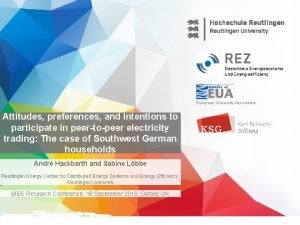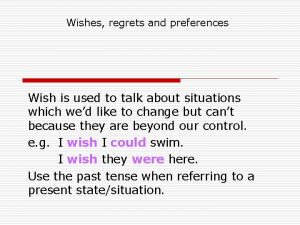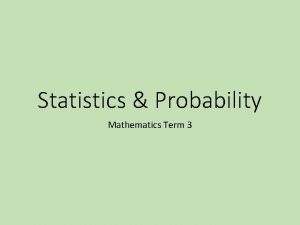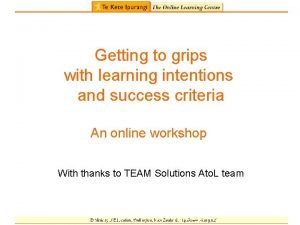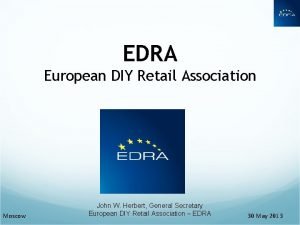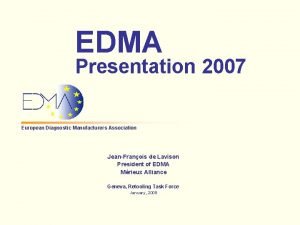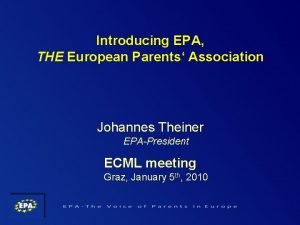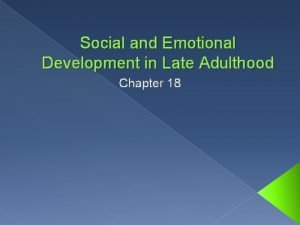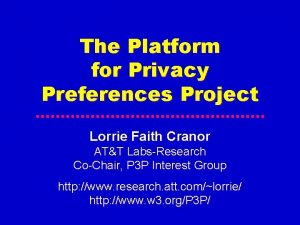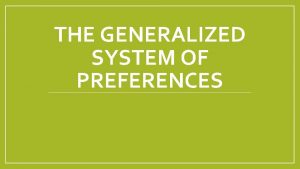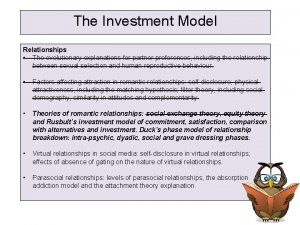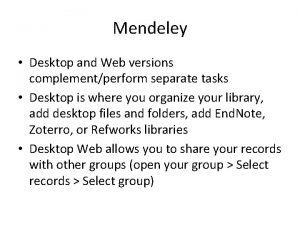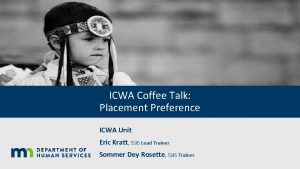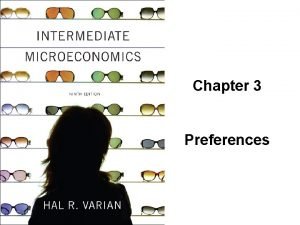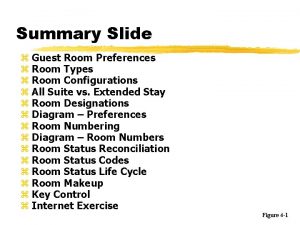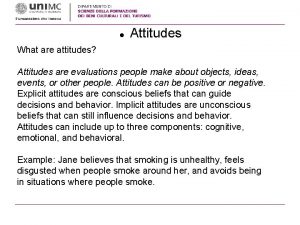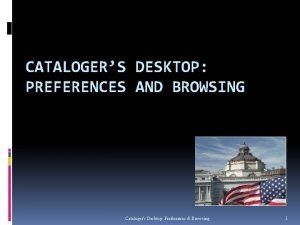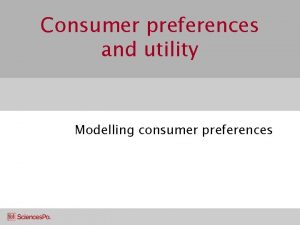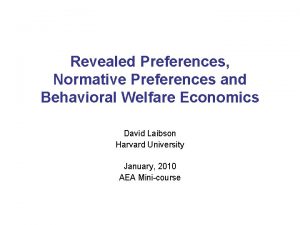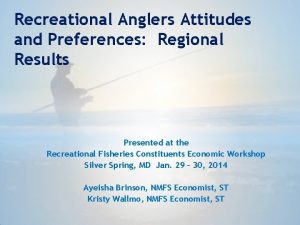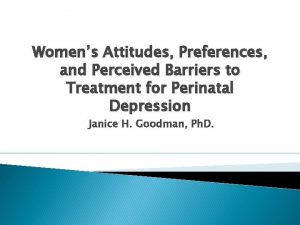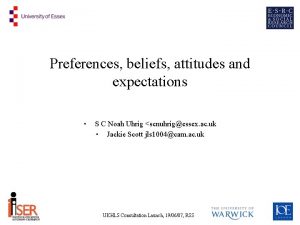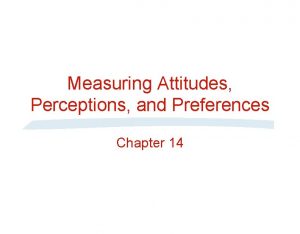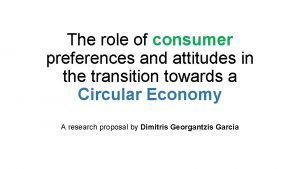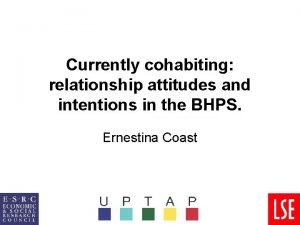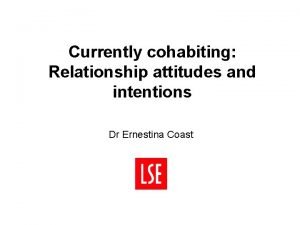European University Association Attitudes preferences and intentions to





























- Slides: 29

European University Association Attitudes, preferences, and intentions to participate in peer-to-peer electricity trading: The case of Southwest German households André Hackbarth and Sabine Löbbe Reutlingen Energy Center for Distributed Energy Systems and Energy Efficiency, Reutlingen University BIEE Research Conference, 18 September 2018, Oxford, UK André Hackbarth and Sabine Löbbe, Reutlingen Energy Center for Distributed Energy Systems and Energy Efficiency, Reutlingen University BIEE Research Conference, 18 September 2018, Oxford, UK 1

Outline Motivation Research goals Prior research Data and methodology Results Summary and conclusions André Hackbarth and Sabine Löbbe, Reutlingen Energy Center for Distributed Energy Systems and Energy Efficiency, Reutlingen University BIEE Research Conference, 18 September 2018, Oxford, UK 2

Outline Motivation Research goals Prior research Data and methodology Results Summary and conclusions André Hackbarth and Sabine Löbbe, Reutlingen Energy Center for Distributed Energy Systems and Energy Efficiency, Reutlingen University BIEE Research Conference, 18 September 2018, Oxford, UK 3

Motivation • Status Quo • Share of renewable electricity of 36. 2% in 2017 (AGEB, 2018) • About 1. 7 million renewable electricity producers (Bundesnetzagentur, 2018) • 31. 5% of the production capacities owned by private households (Trend. Research, 2016) • Governmental support and market development • ‘German Renewable Energy Sources Act’ introduced fixed feed-in tariffs for renewable electricity in 2000, guaranteed for a period of 20 years Subsidization runs out for first renewable generation Electricity has to be used entirely on site or sold/shared by producers • Perspectives for innovation: Cooperative virtual and decentral market places for peerto-peer (P 2 P) energy trading and sharing, supported by EU (EC, 2016) • Research activities • Consumer research concerning P 2 P electricity trading still scarce • Exception: Reuter and Loock (2017), using survey data from 830 respondents in Germany, Switzerland, Norway and Spain to assess participation in local energy André Hackbarth and Sabine Löbbe, Reutlingen Energy Center for Distributed Energy Systems and Energy Efficiency, Reutlingen University markets BIEE Research Conference, 18 September 2018, Oxford, UK 4

Outline Motivation Research goals Prior research Data and methodology Results Summary and conclusions André Hackbarth and Sabine Löbbe, Reutlingen Energy Center for Distributed Energy Systems and Energy Efficiency, Reutlingen University BIEE Research Conference, 18 September 2018, Oxford, UK 5

Research goals • Identification of private energy consumer and prosumer segments willing to participate in P 2 P electricity trading • Socio-demographic and household characteristics • Motivations and attitudes • Product attribute preferences • Quantification of their influence on decision making process • Description of the implications for marketing strategies of energy suppliers André Hackbarth and Sabine Löbbe, Reutlingen Energy Center for Distributed Energy Systems and Energy Efficiency, Reutlingen University BIEE Research Conference, 18 September 2018, Oxford, UK 6

Outline Motivation Research goals Prior research Data and methodology Results Summary and conclusions André Hackbarth and Sabine Löbbe, Reutlingen Energy Center for Distributed Energy Systems and Energy Efficiency, Reutlingen University BIEE Research Conference, 18 September 2018, Oxford, UK 7

Prior research (I) • Research on households’ drivers and barriers for participating in P 2 P electricity trading still scarce Related research fields Motivation for participation in the sharing economy (e. g. Bucher et al. , 2016; Balck and Cracau, 2015; Hamari et al. , 2015; Akbar et al. , 2016; Gossen et al. , 2016; Schor and Fitzmaurice, 2015; Milanova and Maas, 2017; Codagnone et al. , 2016; Andreotti et al. , 2017) Motivation for participation in community energy projects (e. g. Seyfang et al. , 2013; Dóci and Vasileiadou, 2015; Holstenkamp and Kahla, 2016; Kalkbrenner and Roosen, 2016; Kaphengst and Velten, 2014; Gamel et al. , 2016; Hicks and Ison, 2018; Boon and Dieperink, 2014) Motivation for adoption of microgeneration technologies (e. g. Kairies et al. , 2016; Balcombe et al. , 2013, 2014; Ruotsalainen et al. , 2017; Shelly, 2014; Claudy et al. , 2011; Wolske et al. , 2017, Karakaya et al. , 2015; Oberst and Madlener, 2015; Ford et al. , 2016; Korcaj et al. , 2015; Islam, 2014; Strupeit and Palm, 2016; Bergek and Mignon, 2017; Kastner and Matthies, 2016, Kowalska-Pyzalska, 2018; Michaels and Parag, 2016; Kahma and Matschoss, 2017, Nygrén et al. , 2015; Sardianou and Genoudi, 2013) Motivation for choice of green electricity and time-of-use tariffs (e. g. Oerlemans et al. , 2016; Ma et al. , 2015; Ma and Burton, 2016; Sundt and Rehdanz, 2015; Sagebiel et al. , 2014; Litvine and Wüstenhagen, 2011; Yang et al. , 2015; Tabi et al. , 2014; Hartmann and Apaolaza-Ibáñez, 2012) Motivation for adoption of smart energy products (e. g. Gölz and Hahnel, 2016; Forsa, 2010; PWC, 2015; Buchanan et al. , 2016; van der Werff and Steg, 2016; BMWi, 2014; Gangale et al. , 2013; Girod et al. , 2017) André Hackbarth and Sabine Löbbe, Reutlingen Energy Center for Distributed Energy Systems and Energy Efficiency, Reutlingen University BIEE Research Conference, 18 September 2018, Oxford, UK 8

Prior research (II) • Summary of main influencing factors Economy Energy cost savings/payments for production, secure investment and ROI, payback period Autonomy Self-sufficiency, independence from utility, possibility to participate in energy transition Community Desire to share and to integrate into a community (democracy and codetermination) Ecology Energy savings, emission mitigation, resource protection, promotion of certain energy source Regionality Regional or local production and ownership structure of supplier (energy community, municipal utility), support of neighborhood/local community Comfort and safety Accessible, trouble-free, time-saving service or personal assistance, reliability and trustworthiness of the supplier, data security and privacy, security of energy supply Technology Individualized offers (mass customization), general technical interest and innovativeness (do-it-yourself), reliability and simplicity of technology (plug-and-play) Knowledge Specific interest in, knowledge of or familiarity with the product Intrinsic and extrinsic values Ideology (anti-capitalism, social responsibility, generosity), expression of modern lifestyle (self-identity, image/signaling), ‘warm glow’, hedonic motivations, peer effects Sociodemographics Younger, male, homeowners, larger household, high income, high educational level, high technical interest, knowledge of/experience with energy technologies, suburban/rural areas André Hackbarth and Sabine Löbbe, Reutlingen Energy Center for Distributed Energy Systems and Energy Efficiency, Reutlingen University BIEE Research Conference, 18 September 2018, Oxford, UK 9

Outline Motivation Research goals Prior research Data and methodology Results Summary and conclusions André Hackbarth and Sabine Löbbe, Reutlingen Energy Center for Distributed Energy Systems and Energy Efficiency, Reutlingen University BIEE Research Conference, 18 September 2018, Oxford, UK 10

Data and methodology Data • • • Survey carried out in April and May 2017 among 100, 756 customers of seven municipal utilities mainly located in Southwest Germany Aimed at assessment of energy-related products: bundle products, smart home, domestic microgeneration, and P 2 P electricity trading Distributed in paper-pencil version and webbased version Supplier-specific response rate ranged from 1. 3% to 21. 2% with an average of about 7%, depending on means of delivery 7, 006 completed questionnaires in total, 4148 completed surveys available for analysis of P 2 P electricity trading Methodology • • Multiple regression analysis to detect variables with significant influence on the dependent variables Purchase intention of P 2 P electricity trading products Openness towards P 2 P electricity trading products Hierarchical multiple regression model to test incremental power of each retained significant predictor category André Hackbarth and Sabine Löbbe, Reutlingen Energy Center for Distributed Energy Systems and Energy Efficiency, Reutlingen University BIEE Research Conference, 18 September 2018, Oxford, UK 11

Outline Motivation Research goals Prior research Data and methodology Results Summary and conclusions André Hackbarth and Sabine Löbbe, Reutlingen Energy Center for Distributed Energy Systems and Energy Efficiency, Reutlingen University BIEE Research Conference, 18 September 2018, Oxford, UK 12

Results (I) – Hierarchical multiple regression: Purchase intention of P 2 P electricity trading Constant Middle age Shared generation and consumption Transparency of electricity generation Personal service Energy costs Independence from energy provider Easy implementation Telecom company Time-of-use tariff Bundle tariff Microgeneration Knowledge about P 2 P electricity trading Openness towards P 2 P electricity trading Model 1 Model 2 Model 3 Model 4 Unstandardized coefficients B -0. 667 0. 093 0. 055 0. 029 -0. 069 -0. 091 -0. 056 0. 060 0. 053 0. 036 0. 090 0. 289 0. 188 0. 589 R 2 0. 012 0. 117 0. 327 0. 445 Added in model Standardized coefficients β 0. 043 0. 052 0. 028 -0. 055 -0. 067 -0. 052 0. 039 0. 050 0. 044 0. 106 0. 327 0. 065 T -6. 669 3. 710 3. 468 2. 072 -3. 913 -4. 855 -3. 848 2. 704 4. 262 3. 691 8. 690 26. 176 5. 522 P 0. 000 0. 001 0. 038 0. 000 0. 007 0. 000 1 1 2 2 2 2 3 3 3 4 0. 021 0. 400 Δ R 2 F change 0. 012 51. 168 0. 105 70. 135 0. 210 429. 307 0. 118 440. 926 28. 632 P 0. 000 4 Std. err. 0. 100 0. 025 0. 016 0. 014 0. 018 0. 019 0. 014 0. 022 0. 010 0. 011 0. 034 Notes: F = 254. 983 (dfs = 13, 4134; significant at the p < 0. 001 level); Adjusted R 2 = 0. 443; N = 4148. André Hackbarth and Sabine Löbbe, Reutlingen Energy Center for Distributed Energy Systems and Energy Efficiency, Reutlingen University BIEE Research Conference, 18 September 2018, Oxford, UK 13

Results (II) – Hierarchical multiple regression: Purchase intention of P 2 P electricity trading Impact on purchase intention – standardized coefficients (descending order): • Openness towards P 2 P electricity trading (0. 400), • Purchase intention of microgeneration (0. 327) • Purchase intention of a bundle tariff (0. 106) • Importance of energy costs (-0. 067) • Knowledge about P 2 P electricity trading (0. 065) • Importance of personal service (-0. 055) • Importance of shared generation and consumption (0. 052) • Importance of independence from energy supplier (-0. 052) • Telecom company (0. 050) • Time-of-use tariff (0. 044) • Middle age (0. 043) • Importance of easy implementation (0. 039) • Importance of transparency of electricity generation (0. 028) André Hackbarth and Sabine Löbbe, Reutlingen Energy Center for Distributed Energy Systems and Energy Efficiency, Reutlingen University BIEE Research Conference, 18 September 2018, Oxford, UK 14

Results (III) – Hierarchical multiple regression: Openness towards P 2 P electricity trading Constant Middle age Higher education Lower Income Prosumer Rented accommodation Residential location Information: Family and friends Communication: Social media Utility evaluation Knowledge about P 2 P electricity Decision control P 2 P participants among acquaintances Attitude towards environment, regional production and transparency Attitude change Price consciousness Regular provider change Independence from energy provider Model 1 Model 2 Model 3 Model 4 Unstandardized coefficients Std. B err. 0. 382 0. 102 0. 079 0. 021 0. 072 0. 021 0. 064 0. 021 0. 130 0. 030 0. 131 0. 024 -0. 030 0. 012 0. 061 0. 021 0. 041 0. 009 0. 134 0. 018 0. 130 0. 029 0. 039 0. 010 0. 141 0. 012 Standardized coefficients Added in model β T P 0. 054 0. 051 0. 045 0. 064 0. 084 -0. 036 0. 042 0. 068 0. 116 0. 066 0. 058 0. 169 3. 746 3. 719 3. 456 3. 055 4. 318 5. 528 -2. 426 2. 921 4. 711 7. 325 4. 457 4. 089 11. 326 0. 000 0. 001 0. 002 0. 000 0. 015 0. 004 0. 000 1 1 1 1 2 2 2 3 3 3 0. 315 0. 018 0. 275 17. 119 0. 000 4 0. 033 0. 029 0. 023 0. 056 0. 009 0. 011 0. 053 0. 047 0. 033 0. 080 3. 554 3. 051 2. 116 5. 228 0. 000 0. 002 0. 034 0. 000 4 4 R 2 0. 030 0. 078 0. 126 0. 217 Δ R 2 0. 030 0. 048 0. 092 F change 19. 945 68. 522 71. 452 91. 618 P 0. 000 Notes: F = 63. 933 (dfs = 17, 3915; significant at the p < 0. 001 level); Adjusted R 2 = 0. 214; N = 3933. André Hackbarth and Sabine Löbbe, Reutlingen Energy Center for Distributed Energy Systems and Energy Efficiency, Reutlingen University BIEE Research Conference, 18 September 2018, Oxford, UK 15

Results (IV) – Hierarchical multiple regression: Openness towards P 2 P electricity trading Impact on general openness – standardized coefficients (descending order): • Attitude towards environment, regional production, and transparency (0. 275) • P 2 P participants among acquaintances (0. 169) • Utility evaluation (0. 116) • Rented accommodation (0. 084) • Independence from energy provider (0. 080) • Social media as communication channel with the utility (0. 068) • Knowledge about P 2 P electricity trading (0. 066) • Prosumer (0. 064) • Decision control (0. 058) • Middle age (0. 054) • Attitude change (0. 053) • Higher education (0. 051) • Price consciousness (0. 047) • Lower income (0. 045) • Family and friends as main energy-related information source (0. 042) • Residential location (-0. 036) • Regular provider change (0. 033) André Hackbarth and Sabine Löbbe, Reutlingen Energy Center for Distributed Energy Systems and Energy Efficiency, Reutlingen University BIEE Research Conference, 18 September 2018, Oxford, UK 16

Outline Motivation Research goals Data and methodology Results Summary and conclusions André Hackbarth and Sabine Löbbe, Reutlingen Energy Center for Distributed Energy Systems and Energy Efficiency, Reutlingen University BIEE Research Conference, 18 September 2018, Oxford, UK 17

Summary and conclusions (I) • • • P 2 P electricity trading still rather unknown product for many potential customers (85%); only 11% of respondents declared they intend to purchase product in upcoming two years Most likely provider consumers would purchase from is (municipal) utility; telecom company significantly more often selected by interested customer segments Low importance of socio-demographic and household characteristics in explaining differences between consumers (1 -3%) High explanatory power of attitudes, knowledge and likelihood to purchase further products Openness towards P 2 P electricity trading has by far greatest direct influence on purchase intention and also acts as moderator André Hackbarth and Sabine Löbbe, Reutlingen Energy Center for Distributed Energy Systems and Energy Efficiency, Reutlingen University BIEE Research Conference, 18 September 2018, Oxford, UK 18

Summary and conclusions (II) Most valuable target groups for P 2 P electricity trading are innovators and early adopters • • • Middle aged, higher educated, having lower income, live in (sub-)urban areas, being either home owners (prosumers/interested in microgeneration) or living in rented accommodations, having preferences for digital communication channels Well-informed about and open towards P 2 P electricity sharing Environmentally aware and favoring regional production, price conscious and regular changing provider, recently changed attitude towards energy High importance of transparency, sharing generation and consumption, and easy implementation, to a lesser extent economic reasons Intention to purchase related products (e. g. microgeneration, bundle or TOU tariffs) André Hackbarth and Sabine Löbbe, Reutlingen Energy Center for Distributed Energy Systems and Energy Efficiency, Reutlingen University BIEE Research Conference, 18 September 2018, Oxford, UK 19

Summary and conclusions (II) Marketing efforts of incumbent publicly-owned regional/municipal utilities should • Use positive consumer evaluation and trust (safety, reliability, known partner) for development of new business models • Aim at innovators/early adopters with innovative lifestyle (signaling, ‘warm glow’) • Aim at (uninvolved) ‘pure’ consumers and tenants Crucial to realize functioning and lively P 2 P electricity trading community • Link easy-to-use digitalized services with (at least) the look and feel of personalized and P 2 P-based distribution and tailored communication • Create bundles with other products, e. g. electric mobility, microgeneration • Address added values based on fair pricing • Create emotionally framed information campaigns • Particularly take peer effects actively into account, as they have great influence Future research on general openness towards and purchase intention for P 2 P electricity products • Detailed follow-up survey solely focusing on P 2 P electricity trading • Differentiated between consumers and prosumers and their specific interests and motivations André Hackbarth and Sabine Löbbe, Reutlingen Energy Center for Distributed Energy Systems and Energy Efficiency, Reutlingen University BIEE Research Conference, 18 September 2018, Oxford, UK 20

Thank you for your attention! Questions? André Hackbarth Tel: +49 7121 2717131 Email: andre. hackbarth@reutlingen-university. de André Hackbarth and Sabine Löbbe, Reutlingen Energy Center for Distributed Energy Systems and Energy Efficiency, Reutlingen University BIEE Research Conference, 18 September 2018, Oxford, UK 21

Backup André Hackbarth and Sabine Löbbe, Reutlingen Energy Center for Distributed Energy Systems and Energy Efficiency, Reutlingen University BIEE Research Conference, 18 September 2018, Oxford, UK 22

Sample vs German population Variable Gender Age Education Household income per month Number of persons in household Residential location Accommodation type Electricity tariff Value Female Male Less than 18 18 to 39 40 to 59 60 or above No form of school leaving qualification Still in school education Secondary general school leaving qualification Intermediate school leaving qualification Higher education entrance qualification University (of applied sciences) degree Less than € 2, 000 to € 3, 999* € 4, 000* to € 5, 999 € 6, 000 or more Not stated 1 2 3 4 5 or more City Urban district Rural district with urban agglomeration Sparsely populated rural district Rented house (single-family/two-family) Rented apartment House (single-family/two-family) ownership Apartment ownership Green electricity Other Not stated Sample (%) 29. 5 70. 5 19. 3 44. 6 36. 1 0. 3 12. 7 Population (%) 50. 7 49. 3 13. 2 26. 6 29. 8 27. 4 4. 0 3. 6 30. 4 26. 9 17. 2 42. 9 15. 7 33. 6 17. 4 5. 6 27. 7 18. 4 43. 2 17. 8 14. 4 6. 2 51. 0 28. 5 18. 6 1. 9 3. 4 26. 9 57. 5 12. 2 46. 6 43. 1 10. 3 29. 7 14. 2 17. 7 43. 2 43. 0 8. 2 5. 7 41. 8 33. 5 12. 0 9. 3 3. 4 29. 0 39. 0 17. 3 14. 7 10. 5 46. 5 33. 6 9. 4 22. 0 78. 0 - André Hackbarth and Sabine Löbbe, Reutlingen Energy Center for Distributed Energy Systems and Energy Efficiency, Reutlingen University BIEE Research Conference, 18 September 2018, Oxford, UK 23

PCA and PFA No. 1 2 3 4 5 6 7 Component Cronbach's Statement α Openness towards P 2 P 0. 840 My family and friends would approve if I buy a P 2 P electricity product. electricity trading P 2 P electricity trading is innovative and modern. P 2 P electricity trading would go well with me and my lifestyle. P 2 P electricity trading is associated with more advantages than disadvantages compared to a normal electricity tariff. Participation in P 2 P electricity trading is easy. Attitude towards 0. 753 I am concerned about human behavior and its impact on the climate and the environment, regional production and transparency People should live more environmentally friendly to counteract climate change. More detailed information about the origin and production of products is important to me. I always pay attention to ecological criteria when buying products and services. I prefer regional products and services. Utility evaluation 0. 887 My energy provider is customer-oriented. My energy provider is interested in the common good. My energy provider is innovative. My energy provider is environmentally friendly. My energy provider acts proactively. My energy provider is inexpensive. My energy provider is reliable. My energy provider is regionally connected. Technical interest 0. 597 I always have the latest technical products. I am interested in technical novelties. Price and 0. 515 I regularly change my electricity, gas or telecommunications tariff or provider. independence I want the cheapest price and would dispense with customer service in the vicinity. consciousness I would like to be more independent of my energy provider. Knowledge and 0. 094 It is my sole decision whether to participate in P 2 P electricity trading. decision of P 2 P I know people who already participate in P 2 P electricity trading Attitude change I have changed my attitude towards energy in recent years. Mean Std. dev. Loading 3. 03 0. 973 0. 818 3. 76 3. 19 3. 14 0. 898 1. 033 0. 850 0. 803 0. 799 0. 788 2. 96 4. 34 0. 825 0. 850 0. 662 0. 812 4. 39 3. 91 3. 71 4. 11 3. 95 3. 80 3. 70 3. 93 3. 68 3. 41 4. 38 4. 21 2. 77 3. 89 1. 78 0. 803 0. 956 0. 889 0. 870 0. 831 0. 881 0. 863 0. 793 0. 866 0. 886 0. 689 0. 776 0. 911 1. 006 1. 001 0. 794 0. 667 0. 605 0. 525 0. 837 0. 819 0. 811 0. 802 0. 772 0. 733 0. 647 0. 503 0. 821 0. 754 0. 746 2. 69 3. 21 4, 02 1. 163 1. 027 1. 051 0. 716 0. 575 0. 827 3. 52* 0. 863 0. 518 3. 56 1. 135 0. 824 André Hackbarth and Sabine Löbbe, Reutlingen Energy Center for Distributed Energy Systems and Energy Efficiency, Reutlingen University BIEE Research Conference, 18 September 2018, Oxford, UK 24

Data Variable Definition Socio-demographic and household characteristics Middle age 1 if respondent is between 40 and 69 years old, 0 otherwise Lower income 1 if respondent has a net household income of up to € 4000, 0 otherwise Higher education 1 if respondent has a higher education entrance qualification or university degree, 0 otherwise Rented accommodation 1 if respondent lives in a rented accommodation (house or apartment), 0 otherwise Residential location 4 -point scale of household's residential location, ranging from '1 = central city' to '4 = rural area' Prosumer 1 if respondent is a prosumer, 0 otherwise Attitudes, knowledge and behavior Openness towards P 2 P Respondent's openness towards P 2 P electricity trading (average of the five 5 -point electricity trading Likert scale 1 item scores) Attitude towards environment, Respondent's attitude towards the environment, regional production and transparency of products (average of the five 5 -point Likert scale 1 item scores) transparency Utility evaluation Respondent's evaluation of their (local) energy provider (average of the eight 5 point Likert scale 2 item scores) Knowledge about P 2 P electricity 1 if respondent already knew about P 2 P electricity trading before participation in trading study, 0 otherwise Decision control Respondent’s degree of accordance to the statement: ‘It is my sole decision whether to participate in P 2 P electricity trading. ’ (5 -point Likert scale 1) P 2 P participants among Respondent’s degree of accordance to the statement: ‘I know people who already acquaintances participate in P 2 P electricity trading. ’ (5 -point Likert scale 1) Attitude change Respondent’s degree of accordance to the statement: ‘I have changed my attitude towards energy in recent years. ’ (5 -point Likert scale 1) Price consciousness Respondent’s degree of accordance to the statement: ‘I want the cheapest price and would dispense with customer service in the vicinity. ’ (5 -point Likert scale 1) Regular provider change Respondent’s degree of accordance to the statement: ‘I regularly change my electricity, gas or telecommunications tariff or provider. ’ (5 -point Likert scale 1) Independence from energy Respondent’s degree of accordance to the statement: ‘I would like to be more provider independent of my energy provider. ’ (5 -point Likert scale 1) Mean Min Max 0. 62 0. 51 0. 55 Std. dev. 0. 485 0. 500 0. 498 0 0 0 1 1 1 0. 28 1. 68 0. 451 0. 836 0 1 1 4 0. 14 3. 21 0. 346 0. 703 0 1 1 5 4. 10 0. 616 1 5 3. 89 0. 610 1 5 0. 15 0. 360 0 1 4. 02 1. 048 1 5 1. 47 0. 847 1 5 3. 57 1. 124 1 5 2. 68 1. 157 1 5 1. 78 1. 000 1 5 3. 20 1. 019 1 5 André Hackbarth and Sabine Löbbe, Reutlingen Energy Center for Distributed Energy Systems and Energy Efficiency, Reutlingen University BIEE Research Conference, 18 September 2018, Oxford, UK 25

Data Variable Importance of product attributes Shared generation and consumption Transparency of electricity generation Personal service Energy costs Independence from energy provider Easy implementation Telecom company Purchase intention P 2 P electricity trading Microgeneration Bundle tariff Time-of-use tariff Definition Importance of shared electricity generation and consumption in purchase decision (5 -point Likert scale 3) Importance of transparency of electricity generation in purchase decision (5 -point Likert scale 3) Importance of personal service in purchase decision (5 -point Likert scale 3) Importance of (reduction of) energy costs in purchase decision (5 -point Likert scale 3) Importance of independence from energy provider in purchase decision (5 -point Likert scale 3) Importance of ease of implementation in purchase decision (5 -point Likert scale 3) Likelihood of purchasing P 2 P electricity trading product from a telecom company (5 -point Likert scale 4) Purchase probability of P 2 P electricity trading in the upcoming 2 years (5 -point Likert scale 4) Purchase probability of microgeneration technology in the upcoming 2 years (5 point Likert scale 4) Purchase probability of a bundle tariff in the upcoming 2 years (5 -point Likert scale 4) Respondent’s degree of accordance to the statement: ‘I want to have a timedependent electricity tariff. Then I could at least partially transfer my consumption to the cheapest time (e. g. washing at night) and, thus, save money. ’ (5 -point Likert scale 1) Mean Min Max 3. 92 Std. dev. 0. 974 1 5 3. 88 1. 023 1 5 4. 09 4. 35 0. 822 0. 769 1 1 5 5 3. 79 0. 973 1 5 4. 39 2. 03 0. 681 0. 979 1 1 5 5 2. 15 1. 035 1 5 2. 33 1. 167 1 5 2. 77 1. 215 1 5 3. 02 1. 282 1 5 Information and Communication Information: Family and friends 1 if information source on energy topics is family and friends, 0 otherwise 0. 38 0. 484 0 1 Communication: Social media Importance of apps, social media and short messages as means of communication 2. 16 1. 163 0 1 Notes: 1 = The 5 -point Likert scale ranges from '1 = strongly disagree' to '5 = strongly agree'; 2 = The 5 -point Likert scale ranges from '1 = applies not at all' to '5 = 3 item scores) with energy provider (average of the three 5 -point Likert scale applies fully'; 3 = The 5 -point Likert scale ranges from '1 = not at all important' to '5 = very important'; 4 = The 5 -point Likert scale ranges from '1 = very unlikely' to '5 = very likely'. André Hackbarth and Sabine Löbbe, Reutlingen Energy Center for Distributed Energy Systems and Energy Efficiency, Reutlingen University BIEE Research Conference, 18 September 2018, Oxford, UK 26

Data Attitudes Attitude towards environment, regional production and transparency (4. 10), decision control concerning the participation in P 2 P electricity trading (4. 02), utility evaluation (3. 89), attitude change (3. 57), technical interest (3. 33), general openness towards P 2 P electricity trading (3. 21), need for independence from the electric utility (3. 20), price consciousness (2. 68), regular provider change (1. 78), awareness of people who already participate in P 2 P electricity trading (1. 47) Attributes of a P 2 P electricity trading product Data security (4. 45), ease-of-use (4. 39), easy implementation (4. 39), energy costs (4. 35), climate protection (4. 29), personal service (4. 09), purchase price (4. 06), shared generation and consumption (3. 92), transparency of electricity generation (3. 88), independence from energy provider (3. 79) Companies consumers would most likely purchase the product from Energy provider (4. 20), specialized technology companies (3. 45), telecommunication companies (2. 13) Purchase intention of P 2 P electricity trading products (2. 15); 1. 5% of the respondents stated that they very likely, and 9. 4% that they likely participate in P 2 P electricity trading in the upcoming two years Purchase intention of related products Microgeneration technologies (2. 33), bundle tariffs (2. 77), time-of-use tariffs (3. 02) Communication channels with the energy provider Customer centers (3. 89), web portals (3. 59), online contact forms (2. 86), social media and apps (2. 16) Energy-related information source Internet in general (0. 59), information of the energy supplier (0. 51), family and friends (0. 38), daily newspapers (0. 37), internet comparison portals (0. 30), TV/radio (0. 27) André Hackbarth and Sabine Löbbe, Reutlingen Energy Center for Distributed Energy Systems and Energy Efficiency, Reutlingen University BIEE Research Conference, 18 September 2018, Oxford, UK 27

Results – Hierarchical multiple regression: Purchase intention of P 2 P electricity trading Impact on purchase intention – unstandardized coefficients (descending order): • Openness towards P 2 P electricity trading (0. 589) • Purchase intention of microgeneration (0. 289) • Knowledge about P 2 P electricity trading (0. 188) • Middle age (0. 093) • Importance of energy costs (-0. 091) • Purchase intention of a bundle tariff (0. 090) • Importance of personal service (-0. 069) • Importance of easy implementation (0. 060) • Importance of independence from energy provider (-0. 056) • Importance of shared generation and consumption (0. 055) • Telecom company (0. 053) • Time-of-use tariff (0. 036) • Importance of transparency of electricity generation (0. 029) André Hackbarth and Sabine Löbbe, Reutlingen Energy Center for Distributed Energy Systems and Energy Efficiency, Reutlingen University BIEE Research Conference, 18 September 2018, Oxford, UK 28

Results – Hierarchical multiple regression: Openness towards P 2 P electricity trading Impact on general openness – unstandardized coefficients (descending order): • Attitude towards environment, regional production and transparency (0. 315) • P 2 P participants among acquaintances (0. 141) • Utility evaluation (0. 134) • Rented accommodation (0. 131) • Knowledge about P 2 P electricity (0. 130) • Prosumer (0. 130) • Middle age (0. 079) • Higher education (0. 072) • Lower Income (0. 064) • Information: Family and friends (0. 061) • Independence from energy provider (0. 056) • Communication: Social media (0. 041) • Decision control (0. 039) • Attitude change (0. 033) • Residential location (-0. 030) • Price consciousness (0. 029) • Regular provider change (0. 023) André Hackbarth and Sabine Löbbe, Reutlingen Energy Center for Distributed Energy Systems and Energy Efficiency, Reutlingen University BIEE Research Conference, 18 September 2018, Oxford, UK 29
 Personal attitudes affect behavior via intentions
Personal attitudes affect behavior via intentions European university association
European university association Wishes and preferences grammar
Wishes and preferences grammar Career choices and preferences in hrm
Career choices and preferences in hrm How to reorder artboards in illustrator
How to reorder artboards in illustrator Learning intentions and success criteria examples
Learning intentions and success criteria examples Learning intentions and success criteria examples
Learning intentions and success criteria examples Learning intentions and success criteria for mathematics
Learning intentions and success criteria for mathematics Examples of learning intentions
Examples of learning intentions Intention prediction arrangement
Intention prediction arrangement The thoughts and intents of the heart
The thoughts and intents of the heart European diy retail association
European diy retail association European diagnostic manufacturers association
European diagnostic manufacturers association European biomass industry association
European biomass industry association Driver diagram palliative care
Driver diagram palliative care Johannes theiner
Johannes theiner Magnetism.eu
Magnetism.eu Examples of claim
Examples of claim Elders' housing preferences reflect a strong desire for
Elders' housing preferences reflect a strong desire for Platform for privacy preferences project
Platform for privacy preferences project Generalised system of preferences wto
Generalised system of preferences wto Vtac aggregate to atar table 2020
Vtac aggregate to atar table 2020 Investment model rusbult
Investment model rusbult Well-behaved preferences
Well-behaved preferences Mendeley desktop preferences
Mendeley desktop preferences Icwa placement preferences
Icwa placement preferences Well-behaved preferences are
Well-behaved preferences are Seas application impact statement example
Seas application impact statement example Flight preferences
Flight preferences Guest room preferences
Guest room preferences

